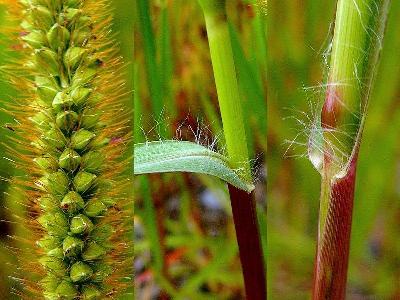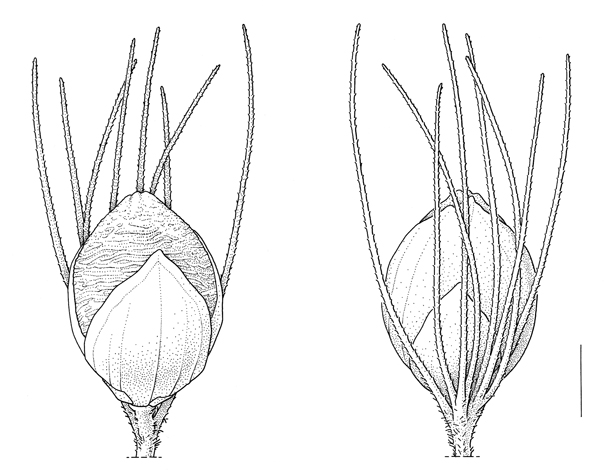5. Setaria pumila (Poiret) Roem. et Schult. (syn.: S. lutescens F.T. Hubbard) (Old World, probably Africa; see Layton & Kellogg 2014) – A common alien – ephemeral as well as naturalised – and maybe even an archaeophyte (documented in the Belgian herbaria, at least, since the beginning of the 19th century but doubtlessly already present before). In the 19th century Setaria pumila was a weed of arable land, especially on sandy soils in the Kempen. Formerly it was also frequently associated with wool importation. At present it is chiefly introduced with cereals and it is one of the more characteristic birdseed aliens nowadays. Setaria pumila is usually found in port- or urban areas, by motorways, on dumps, etc. In such habitats it is usually rather ephemeral. However, in the past decades it is also increasingly found in maize fields as well, especially in Flanders. In some places (predominantly on sandy, sun-exposed soils) it is very persistent and locally becoming naturalised.
A form with smaller spikelets (2-2,5 mm vs. 3-3,4 mm) and reddish bristles (vs. yellowish bristles) might have been overlooked (see for instance Rominger 2003). Such plants are now usually referred to as Setaria pumila subsp. pallidefusca (Schumach.) B.K. Simon but were long accepted as a species of its own [S. pallidefusca (Schumach.) Stapf et C.E. Hubbard]. It is a native of tropical Africa but was formerly sometimes reported as an alien in Europe, for instance in the Netherlands (Jansen 1951).
Setaria pumila is also rather similar to S. parviflora and both have been much confused in Belgian herbaria (see under the latter).
 |
 |

Selected literature:
Hoste I. & Verloove F. (2006) Setaria pumila. In: Van Landuyt W., Hoste I., Vanhecke L., Van den Bremt P., Vercruysse W. & De Beer D., Atlas van de flora van Vlaanderen en het Brussels gewest. Instituut voor Natuur- en Bosonderzoek, Nationale Plantentuin van België en Flo.Wer: 826-827.
Jansen P. (1951) Flora Neerlandica, deel 1, aflevering 2. KNBV, Amsterdam: 272 p.
Layton D.J. & Kellogg E.A. (2014) Morphological, phylogenetic, and ecological diversity of the new model species Setaria viridis (Poaceae: Paniceae) and its close relatives. Am. J. Bot. 101(3): 539-557.
Rominger J.M. (1962) Taxonomy of Setaria (Gramineae) in North America. Illinois Biol. Monogr. 29: 1-132.
Steel M.G. (1983) The biology of Canadian weeds, 59. Setaria glauca (L.) Beauv. and S. verticillata (L.) Beauv. Canad. J. Pl. Sci. 63: 711-725.

